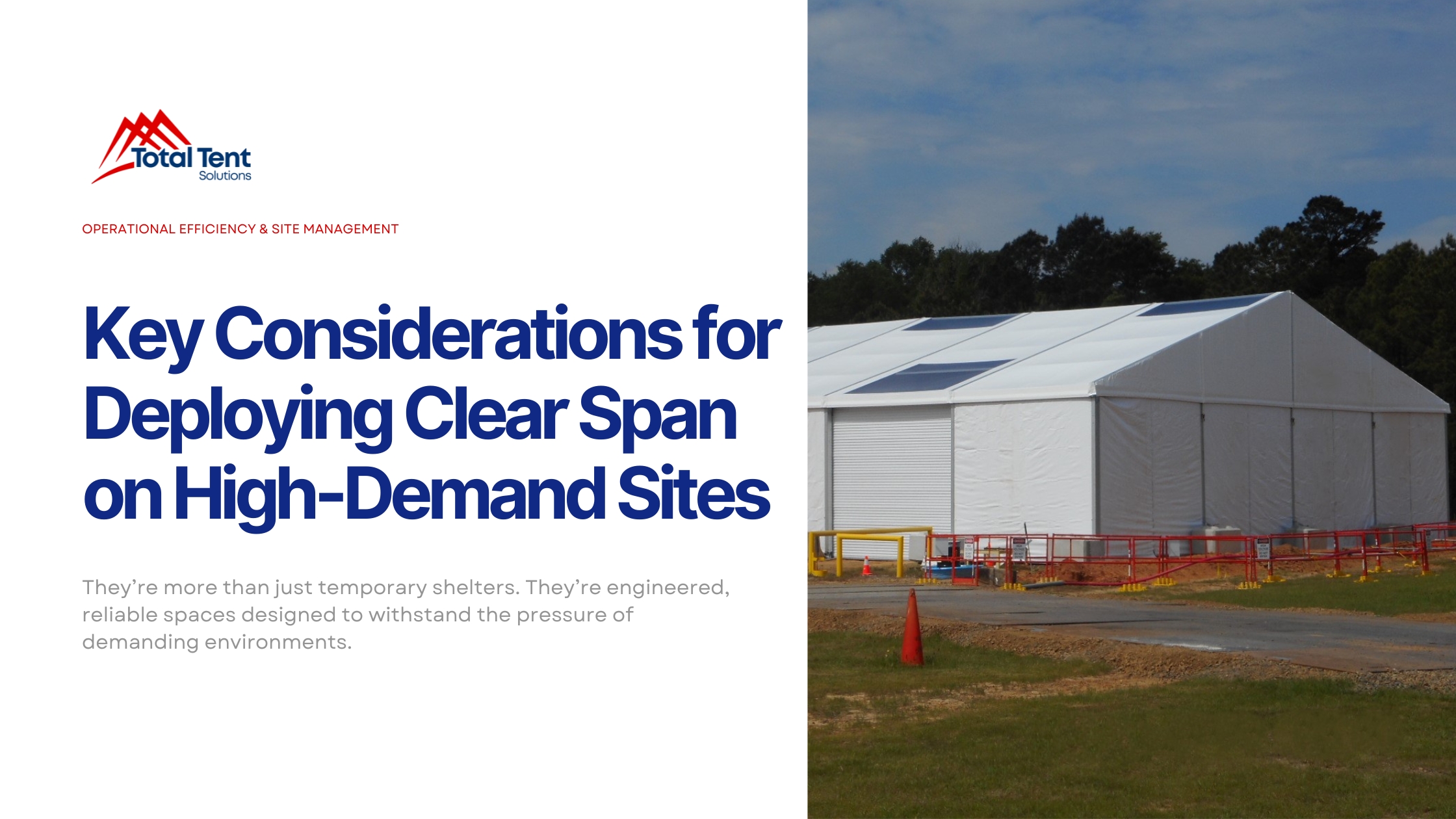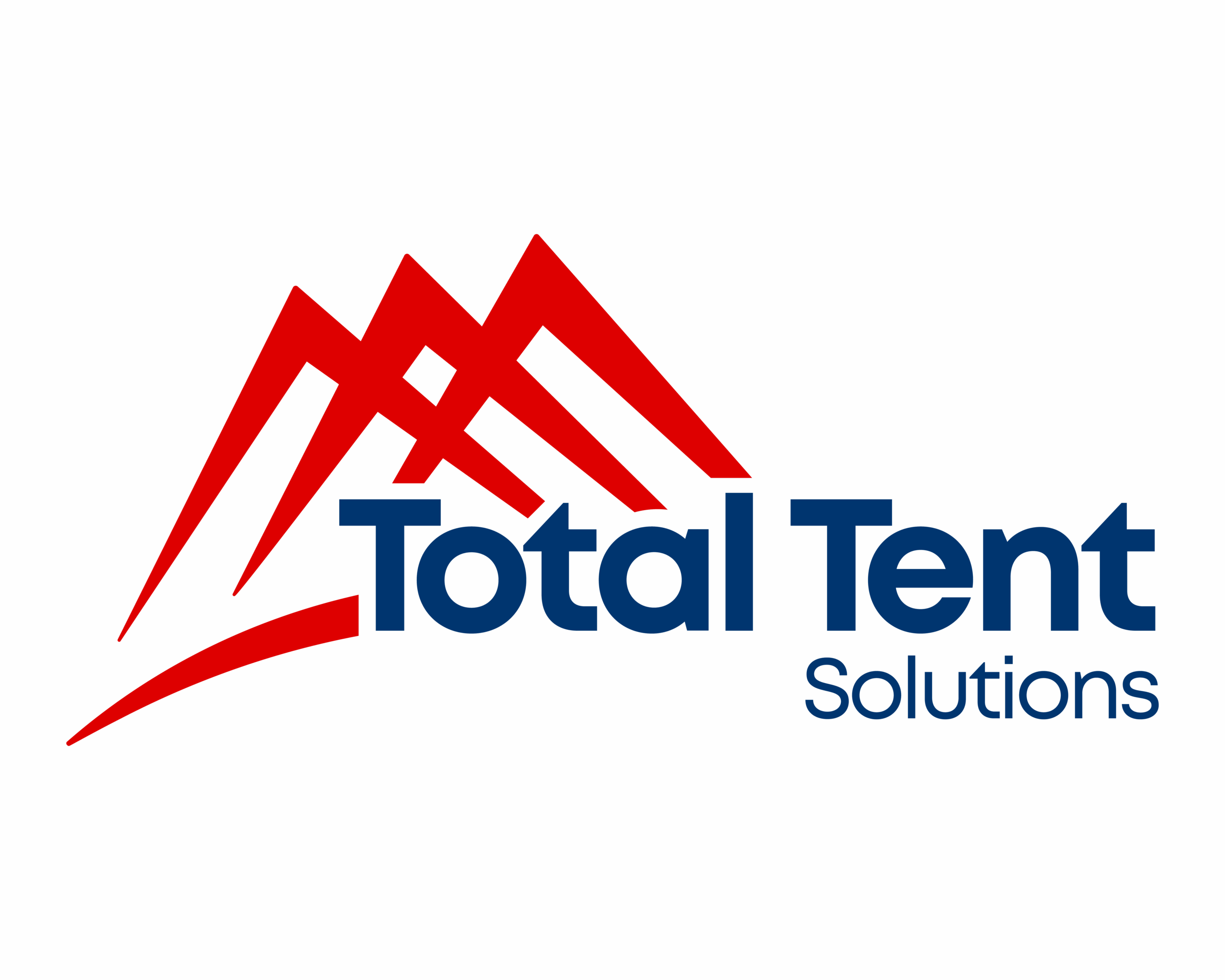
When your project is running at full speed and the clock is ticking, you need solutions that can keep up. That’s where clear span structures step in. They’re more than just temporary shelters. They’re engineered, reliable spaces designed to withstand the pressure of demanding environments. But before you rush to deploy one, there are several key factors you’ll want to think through if you want the structure to perform at its best.
What is a Clear Span Structure
A clear span structure is a type of temporary building with no interior columns or support poles. That design gives you wide-open interior space that’s versatile and highly customizable. Imagine a giant warehouse where nothing gets in the way of equipment, machinery, or foot traffic. That’s what makes these structures so attractive, you can configure them for storage, workshops, break areas, or large-scale gatherings without worrying about wasted space or awkward layouts.
Why Clear Span is Popular in High-Demand Settings
Clear span tents shine in high-demand sites because they combine strength with speed. They go up quickly, handle rough environments, and offer the flexibility to adapt to changing site needs. Instead of waiting months for permanent construction, you can get a safe, functional building in place within days. For industries where downtime costs thousands of dollars an hour, that speed can make the difference between a project that stays on track and one that slips behind schedule.
Understanding High-Demand Sites
What Defines a High-Demand Site
A high-demand site is any location where time, space, and safety are at a premium. These sites often operate under tight deadlines, involve heavy equipment, and require round-the-clock activity. In short, they can’t afford delays, and every piece of infrastructure must perform under pressure. That’s why choosing the right type of temporary structure isn’t just helpful, it’s mission critical.
Common Industries Using Clear Span Tents
Oil and Gas
Turnarounds and shutdowns in refineries are some of the most time-sensitive projects out there. Crews work long shifts in tough conditions, and they need dependable shelters to rest, eat, and work safely. Clear span tents provide climate-controlled environments that protect both people and sensitive equipment, ensuring projects meet tight schedules.
Construction and Infrastructure
From bridge repairs to highway projects, construction teams use clear span tents as staging areas, workshops, and equipment storage. Having a covered, secure space helps protect materials from the elements and keeps crews operating efficiently no matter what the weather throws at them.
Manufacturing and Warehousing
Factories and plants often hit a point where production outpaces available space. Instead of halting operations or rushing into costly permanent construction, many turn to clear span tents for overflow storage or even temporary production lines. It’s a flexible solution that can scale with demand.
Events and Emergency Response
Outside of industrial uses, clear span tents are also the backbone of major events and disaster relief efforts. When a hurricane strikes or a large event needs quick setup, these structures become command centers, shelters, and even temporary hospitals, delivered and installed faster than traditional options.
Structural Design Considerations
Load-Bearing Capacity
You need to know how much weight your structure can handle, from lighting rigs and cranes to racks of heavy materials. Underestimating load-bearing needs can lead to structural issues or safety risks, so engineering calculations upfront are non-negotiable. Clear span tents can be designed to support significant loads, but they must match the reality of your site.
Wind and Snow Ratings
Sites in different climates demand different ratings. A refinery on the Gulf Coast needs a tent designed to withstand high winds and hurricane conditions, while a facility in the Midwest may require snow-load certification to handle winter storms. Choosing the right rating ensures your structure is built for the environment it will face.
Foundation and Anchoring Needs
Even the strongest structure can fail if it’s not anchored properly. Soil type, concrete pads, or ballast systems all influence how a tent is secured. Before deployment, an engineering team should evaluate your site conditions and recommend the best anchoring method to ensure stability and safety.
Customization for Site Needs
Size and Scalability
Clear span structures can range from modest shelters to massive, aircraft-hangar-sized installations. One of their biggest advantages is scalability. If your project expands, the structure can expand with it. You’re not locked into a fixed footprint the way you would be with a traditional building.
Climate Control and HVAC Integration
No one wants to work in sweltering heat or freezing cold. Adding HVAC systems allows clear span tents to be used year-round and creates comfortable, safe environments for workers. For sensitive equipment or materials, temperature control can be just as important as it is for people.
Flooring, Walls, and Interior Layouts
Options range from heavy-duty flooring that can handle forklifts to insulated wall panels for temperature control. Interior layouts can be customized with partition walls, office spaces, and designated break areas. It’s like starting with a blank canvas and tailoring it to your site’s unique needs.
Compliance and Safety Factors
Meeting Industry Regulations
Every industry has its own rules and codes. Whether it’s OSHA, local fire codes, or plant-specific safety requirements, your clear span structure needs to align with them. Non-compliance not only risks fines but also slows projects down if regulators step in.
Fire Safety Standards
Fire safety isn’t optional on a high-demand site. Materials used in clear span construction should be flame-retardant and tested to meet standards. Proper exit signage, extinguishers, and fire suppression options also need to be part of the plan.
Worker Comfort and Security
Safety extends beyond compliance. Adequate lighting, emergency exits, ventilation, and even access control systems keep workers safe and comfortable while reducing the risk of accidents or unauthorized entry.
Installation and Timeline
Site Preparation
Before the first piece of aluminum is laid down, the ground must be cleared, leveled, and ready. Utilities like power and HVAC hookups should also be planned. Preparation reduces installation time and prevents costly surprises later.
Speed of Deployment
One of the biggest advantages of clear span tents is how quickly they can be installed. In many cases, crews can build them in days, not weeks. This rapid deployment is a game-changer for industries where every hour of downtime impacts the bottom line.
Minimizing Downtime
The right provider will coordinate installation around your project schedule. That might mean overnight work or phased installation so operations continue while the structure goes up. Minimizing disruption is key to keeping your site productive.
Cost Considerations
Rental vs. Purchase
Short-term projects often make renting more cost-effective, while long-term use may justify a purchase. Understanding the duration and purpose of your project helps you make the right financial decision.
Long-Term Value
Beyond upfront costs, think about long-term value. A clear span structure can save money by preventing weather-related downtime, protecting equipment, or providing flexible space for future needs.
Avoiding Hidden Costs
Transparent pricing matters. Delivery fees, setup charges, and customization costs can add up quickly. A reliable provider will be upfront so you don’t face budget-busting surprises later.
Logistics and Accessibility
Transportation of Materials
Clear span components are modular but require careful logistics to get them to your site. The larger the structure, the more coordination is needed to ensure materials arrive on time and in sequence.
On-Site Access and Space Constraints
Tight spaces or restricted access points can complicate installation. Planning ahead for road access, crane clearances, and staging areas ensures installation goes smoothly.
Working with Experienced Crews
An experienced installation team can anticipate challenges and solve problems before they become setbacks. Their expertise can be the difference between a project that’s smooth and one that’s delayed.
Environmental Factors
Weather Conditions
Clear span structures are designed to handle rough weather, but no two sites are alike. By planning for your specific conditions, whether that’s desert heat, coastal winds, or mountain snow, you ensure performance and safety.
Energy Efficiency
Insulated panels, reflective roofing, and efficient HVAC systems all contribute to energy efficiency. Lower energy use means lower operating costs, which adds up on long projects.
Sustainable Materials
Some providers offer eco-friendly building materials or recycling programs. Choosing sustainable options not only helps the environment but may also align with company sustainability goals.
Technology and Add-Ons
CAD Design and Engineering Support
CAD modeling allows you to see exactly how your structure will look and function before installation. Engineering support helps avoid costly errors and ensures the structure is fit for purpose.
Lighting, Doors, and Utilities
From hi-bay LED lighting to roll-up doors for heavy equipment, the right add-ons transform a shell into a fully functional workspace. Utilities like plumbing and electrical can also be integrated.
Security and Monitoring Options
For high-value projects, adding cameras, fencing, and access control systems keeps the site secure. These measures protect both workers and assets.
Long-Term Maintenance
Routine Inspections
Just like permanent buildings, clear spans need routine checks for wear, stress, and weather damage. Inspections catch small issues before they become big problems.
Cleaning and Material Care
Proper cleaning extends the life of the fabric and framework. Dirt, debris, and harsh weather can all shorten a structure’s lifespan if not addressed.
Repair and Replacement Planning
Having a plan for quick repairs keeps projects moving. Whether it’s replacing a panel or tightening anchors, a proactive approach ensures minimal downtime.
Choosing the Right Provider
Experience and Track Record
A provider with proven experience in high-demand industries understands the unique challenges and can anticipate issues. Ask for case studies or references before making a decision.
Transparent Pricing
Clear contracts with no hidden fees are a must. The last thing you want is a surprise bill after installation is complete.
Customer Support and Responsiveness
When deadlines are tight, you need a provider who picks up the phone, answers questions, and resolves issues quickly. Good support is as important as the structure itself.
Real-World Examples
Clear Span in Oil Refinery Turnarounds
During refinery shutdowns, crews rely on clear spans for safe work environments that meet deadlines. By providing climate-controlled dining areas and equipment shelters, these structures directly reduce downtime and improve worker productivity.
Clear Span in Disaster Relief Efforts
When hurricanes or earthquakes strike, clear spans are often the first structures deployed. They become hospitals, command centers, and shelters within days, proving their versatility in the toughest conditions.
Conclusion
Deploying clear span structures on high-demand sites isn’t just about putting up a tent. It’s about creating a reliable, safe, and efficient space that keeps your project on track. From structural integrity to compliance, customization, and cost considerations, each factor plays a role in success. By choosing the right provider and planning ahead, you’ll ensure your clear span solution delivers exactly what your site needs both today and tomorrow.
FAQs
1: How long does it take to install a clear span structure on a high-demand site?
Most clear span tents can be installed in a matter of days, depending on size, site conditions, and crew availability.
2: Can clear span structures handle extreme weather conditions?
Yes. When properly engineered and rated for wind or snow loads, they can withstand hurricanes, blizzards, and extreme heat.
3: Are clear span structures customizable for different industries?
Absolutely. They can be outfitted with HVAC systems, heavy-duty flooring, lighting, partition walls, and utilities to fit unique site needs.
4: What is the lifespan of a clear span structure?
With regular inspections and maintenance, clear span structures can last for many years, making them suitable for both short-term and long-term use.
5: Is it better to rent or buy a clear span tent?
That depends on your project timeline. Renting is ideal for short-term needs, while buying makes sense for companies with ongoing or repeated projects.

